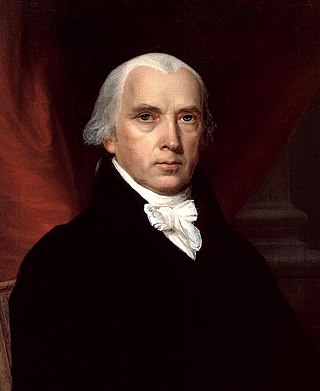
The Constitution of the United States is the supreme law of the United States of America. It superseded the Articles of Confederation, the nation's first constitution, in 1789. Originally comprising seven articles, it delineates the national frame and constraints of government. The Constitution's first three articles embody the doctrine of the separation of powers, whereby the federal government is divided into three branches: the legislative, consisting of the bicameral Congress ; the executive, consisting of the president and subordinate officers ; and the judicial, consisting of the Supreme Court and other federal courts. Article IV, Article V, and Article VI embody concepts of federalism, describing the rights and responsibilities of state governments, the states in relationship to the federal government, and the shared process of constitutional amendment. Article VII establishes the procedure subsequently used by the 13 states to ratify it. The Constitution of the United States is the oldest and longest-standing written and codified national constitution in force in the world today.

Article One of the United States Constitution establishes the legislative branch of the federal government, the United States Congress. Under Article One, Congress is a bicameral legislature consisting of the House of Representatives and the Senate. Article One grants Congress various enumerated powers and the ability to pass laws "necessary and proper" to carry out those powers. Article One also establishes the procedures for passing a bill and places various limits on the powers of Congress and the states from abusing their powers.

The United States Electoral College is the group of presidential electors required by the Constitution to form every four years for the sole purpose of appointing the president and vice president. Each state and the District of Columbia appoints electors pursuant to the methods described by its legislature, equal in number to its congressional delegation. Federal office holders, including senators and representatives, cannot be electors. Of the current 538 electors, an absolute majority of 270 or more electoral votes is required to elect the president and vice president. If no candidate achieves an absolute majority there, a contingent election is held by the House of Representatives to elect the president and by the Senate to elect the vice president.

The Senate is the upper house of the bicameral Parliament of Australia, the lower house being the House of Representatives. The composition and powers of the Senate are established in Chapter I of the Constitution of Australia. There are a total of 76 senators: 12 are elected from each of the six Australian states regardless of population and 2 from each of the two autonomous internal Australian territories. Senators are popularly elected under the single transferable vote system of proportional representation.

Roger Sherman was an American statesman, lawyer, and a Founding Father of the United States. He is the only person to sign four of the great state papers of the United States related to the founding: the Continental Association, Declaration of Independence, Articles of Confederation, and U.S. Constitution. He also signed the 1774 Petition to the King and 1775 Olive Branch Petition.

The Virginia Plan was a proposal to the United States Constitutional Convention for the creation of a supreme national government with three branches and a bicameral legislature. The plan was drafted by James Madison while he waited for a quorum to assemble at the Constitutional Convention of 1787.

United States congressional apportionment is the process by which seats in the United States House of Representatives are distributed among the 50 states according to the most recent decennial census mandated by the United States Constitution. Each state is apportioned a number of seats which approximately corresponds to its share of the aggregate population of the 50 states. Every state is constitutionally guaranteed at least one seat in the House and two seats in the Senate, regardless of population.
The Three-fifths Compromise was an agreement reached during the 1787 United States Constitutional Convention over the inclusion of slaves in a state's total population. This count would determine: the number of seats in the House of Representatives; the number of electoral votes each state would be allocated; and how much money the states would pay in taxes. Slave holding states wanted their entire population to be counted to determine the number of Representatives those states could elect and send to Congress. Free states wanted to exclude the counting of slave populations in slave states, since those slaves had no voting rights. A compromise was struck to resolve this impasse. The compromise counted three-fifths of each state's slave population toward that state's total population for the purpose of apportioning the House of Representatives. Even though slaves were denied voting rights, this gave Southern states more representatives and more presidential electoral votes than if slaves had not been counted. It also gave slaveholders similarly enlarged powers in Southern legislatures; this was an issue in the secession of West Virginia from Virginia in 1863. Free blacks and indentured servants were not subject to the compromise, and each was counted as one full person for representation. It is worthy of noting that although the compromise gave slave holding states more representation in Congress than they originally had, the compromise of counting only 3/5 of the slave population succeeded in reducing what would have been an overwhelming influence in Congress by slave states, had those states been able to send a larger complement of Representatives to Congress that reflected the entire slave populations of those states.

The Connecticut Compromise was an agreement reached during the Constitutional Convention of 1787 that in part defined the legislative structure and representation each state would have under the United States Constitution. It retained the bicameral legislature as proposed by Roger Sherman, along with proportional representation of the states in the lower house or House of Representatives, and it required the upper house or Senate to be weighted equally among the states; each state would have two representatives in the Senate.

The United States Constitution has served as the supreme law of the United States since taking effect in 1789. The document was written at the 1787 Philadelphia Convention and was ratified through a series of state conventions held in 1787 and 1788. Since 1789, the Constitution has been amended twenty-seven times; particularly important amendments include the ten amendments of the United States Bill of Rights and the three Reconstruction Amendments.
Reynolds v. Sims, 377 U.S. 533 (1964), was a landmark United States Supreme Court case in which the Court ruled that the electoral districts of state legislative chambers must be roughly equal in population. Along with Baker v. Carr (1962) and Wesberry v. Sanders (1964), it was part of a series of Warren Court cases that applied the principle of "one person, one vote" to U.S. legislative bodies.
The New Jersey Plan was a proposal for the structure of the United States Government presented during the Constitutional Convention of 1787. Principally authored by William Paterson of New Jersey, the New Jersey Plan was an important alternative to the Virginia Plan proposed by James Madison and Edmund Randolph of Virginia.

The United States Senate is the upper chamber of the United States Congress, which along with the United States House of Representatives—the lower chamber—comprises the legislative branch of the federal government of the United States. Like its counterpart, the Senate was established by the United States Constitution and convened for its first meeting on March 4, 1789 at Federal Hall in New York City. The history of the institution begins prior to that date, at the 1787 Constitutional Convention, in James Madison's Virginia Plan, which proposed a bicameral national legislature, and in the controversial Connecticut Compromise, a 5–4 vote that gave small-population states disproportionate power in the Senate.

Voting rights of citizens in the District of Columbia differ from the rights of citizens in the 50 U.S. states. The United States Constitution grants each state voting representation in both houses of the United States Congress. It defines the federal district as being outside of any state, and does not grant it any voting representation in Congress. The Constitution grants Congress exclusive jurisdiction over the District in "all cases whatsoever".

Federalist No. 52, an essay by James Madison or Alexander Hamilton, is the fifty-second essay out of eighty-five making up The Federalist Papers, a collection of essays written during the Constitution's ratification process, most of them written either by Hamilton or Madison. It was published in the New York Packet on February 8, 1788, with the pseudonym Publius, under which all The Federalist papers were published. This essay is the first of two examining the structure of the United States House of Representatives under the proposed United States Constitution. It is titled The House of Representatives".

Federalist Paper No. 54 is an essay by James Madison, the fifty-fourth of The Federalist Papers. It was first published by The New York Packet on February 12, 1788 under the pseudonym Publius, the name under which all The Federalist papers were published.

Federalist No. 55 is an essay by James Madison, the fifty-fifth of The Federalist Papers. It was first published by The New York Packet on February 13, 1788 under the pseudonym Publius, the name under which all The Federalist Papers were published. It is titled "The Total Number of House of Representatives". It is the first of four papers defending the number of members in the House of Representatives against the critics who believe the number of members to be inadequate. The critics presume that there aren't enough representatives to defend the country against the small group of legislators who are violating the rights of the people. In this paper, Madison examines the size of the United States House of Representatives.

Federalist No. 66 is an essay by Alexander Hamilton, the sixty-sixth of The Federalist Papers. It was published on March 8, 1788, under the pseudonym Publius, the name under which all The Federalist papers were published. The title is "Objections to the Power of the Senate To Set as a Court for Impeachments Further Considered".

The Radicalism of the American Revolution is a nonfiction book by historian Gordon S. Wood, published by Vintage Books as a paperback in 1993. The first printing of the hardcover edition notes a publication date of December 1991. In the book, Wood explores the radical character of the American Revolution. The book was awarded the 1993 Pulitzer Prize for History.

James Madison was an American statesman, diplomat, and Founding Father who served as the 4th president of the United States from 1809 to 1817. He is hailed as the "Father of the Constitution" for his pivotal role in drafting and promoting the Constitution of the United States and the Bill of Rights. Disillusioned by the weak national government established by the Articles of Confederation, he helped organize the Constitutional Convention, which produced a new constitution. Madison's Virginia Plan served as the basis for the Constitutional Convention's deliberations, and he was one of the most influential individuals at the convention. He became one of the leaders in the movement to ratify the Constitution, and he joined with Alexander Hamilton and John Jay in writing The Federalist Papers, a series of pro-ratification essays that was one of the most influential works of political science in American history.













